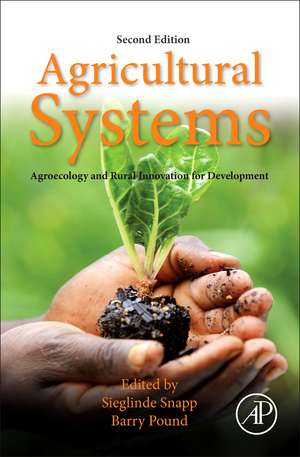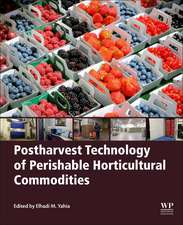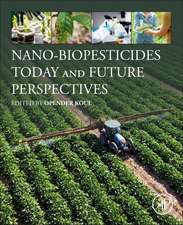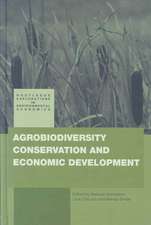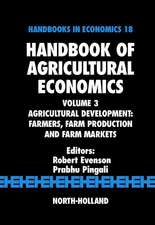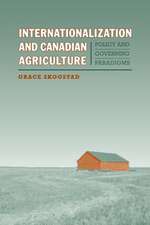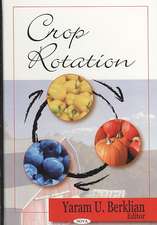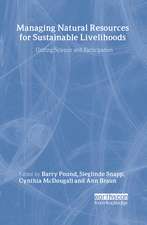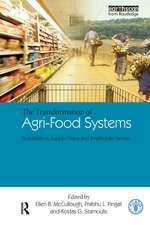Agricultural Systems: Agroecology and Rural Innovation for Development: Agroecology and Rural Innovation for Development
Editat de Sieglinde Snapp, Barry Pounden Limba Engleză Hardback – 17 mar 2017
This book explores topics such as: re-inventing farming systems; principles and practice of agroecology; agricultural change and low-input technology; ecologically-based nutrient management; participatory breeding for developing improved and relevant crops; participatory livestock research for development; gender and agrarian inequality at the local scale; the nature of agricultural innovation; and outreach to support rural innovation. The extensive coverage of subjects is complemented with integrated references and a companion website, making this book essential reading for courses in international agricultural systems and management, sustainable agricultural management, and cropping systems.
This book will be a valuable resource for students of agricultural science, environmental engineering, and rural planning; researchers and scientists in agricultural development agencies; and practitioners of agricultural development in government extension programs, development agencies, and NGOs.
- Provides students with an enhanced understanding of how research can be harnessed for sustainable agriculture
- Incorporates social, biological, chemical, and geographical aspects important to agroecology
- Addresses social and development issues related to farming systems
Preț: 339.78 lei
Preț vechi: 408.08 lei
-17% Nou
Puncte Express: 510
Preț estimativ în valută:
65.02€ • 68.37$ • 53.72£
65.02€ • 68.37$ • 53.72£
Carte tipărită la comandă
Livrare economică 09-23 aprilie
Preluare comenzi: 021 569.72.76
Specificații
ISBN-13: 9780128020708
ISBN-10: 0128020709
Pagini: 558
Ilustrații: Approx. 100 illustrations (50 in full color)
Dimensiuni: 152 x 229 x 33 mm
Greutate: 0.91 kg
Ediția:2
Editura: ELSEVIER SCIENCE
ISBN-10: 0128020709
Pagini: 558
Ilustrații: Approx. 100 illustrations (50 in full color)
Dimensiuni: 152 x 229 x 33 mm
Greutate: 0.91 kg
Ediția:2
Editura: ELSEVIER SCIENCE
Public țintă
Students of agricultural science, environmental engineering, rural planning; researchers and scientists in agricultural development agencies; practitioners of agricultural development in government extension programs, development agencies, and NGOsCuprins
Section I: Reinventing Farming Systems
1. Introduction
2. Agroecology: Principles and Practice
3. Farming-Related Livelihoods
4. Farming Systems for Sustainable Intensification
5. Designing for the Long-term: Sustainable Agriculture
Section II: Resources for Agricultural Development
6. Low-Input Technology: An Integrative View
7. Ecologically Based Nutrient Management
8. Participatory Breeding: Developing Improved and Relevant Crop Varieties With Farmers
9. Research on Livestock, Livelihoods, and Innovation
Section III: Context for Sustainable Agricultural Development
10. Gender and Agrarian Inequities
11. The Innovation Systems Approach to Agricultural Research and Development
12. Outreach to Support Rural Innovation
13. Climate Change and Agricultural Systems
Section IV: Tying It All Together
14. Tying It All Together: Global, Regional, and Local Integrations
1. Introduction
2. Agroecology: Principles and Practice
3. Farming-Related Livelihoods
4. Farming Systems for Sustainable Intensification
5. Designing for the Long-term: Sustainable Agriculture
Section II: Resources for Agricultural Development
6. Low-Input Technology: An Integrative View
7. Ecologically Based Nutrient Management
8. Participatory Breeding: Developing Improved and Relevant Crop Varieties With Farmers
9. Research on Livestock, Livelihoods, and Innovation
Section III: Context for Sustainable Agricultural Development
10. Gender and Agrarian Inequities
11. The Innovation Systems Approach to Agricultural Research and Development
12. Outreach to Support Rural Innovation
13. Climate Change and Agricultural Systems
Section IV: Tying It All Together
14. Tying It All Together: Global, Regional, and Local Integrations
Recenzii
"A valuable set of principles, strategies and case studies that paint a new and feasible greenprint for development. Agricultural Systems is particularly valuable in its practical approach to development and its focus on the role of farmers, especially women, in the process. Each chapter is supported by several case studies that direct the reader’s attention to grassroots strategies that work. The chapter on animal systems is a welcome addition, since many similar books focus almost entirely on cropping systems. It is well written and well worth adding to your personal library and recommending as a resource for students interested in developing countries and their agriculture." --Charles Francis, University of Nebraska, USA
